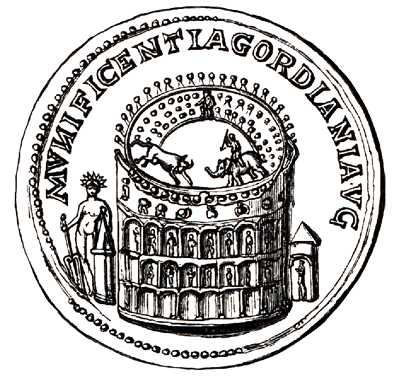
You see the colossal statue of the Sun God (40 m. or 120 ft. high) that stood in front of the Colosseum. The gilded-bronze statue that originally portrayed emperor Nero in the nude was the work of a Greek artist named Zenodorus. At first, it was placed in the vestibule of Nero's palace, the Domus Aurea (the Golden House), but later Vespasian changed it into the statue of the Sun God, or Colossus Solis in Latin1, and Hadrian had it moved closer to the Colosseum to make room for the Temple of Venus and Roma2 (see the actual coin and a labeled drawing). The statue was still standing by 354 CE but was later destroyed. Only its brick pedestal, measuring 7.50 sq. m. (22.5 sq. ft.), remained in front of the Colosseum; that one was finally demolished in 1936. The Colosseum was obviously named after the Colossus, but we should keep in mind that this name was applied to the building only after 1000 CE; before then it was known as the Flavian Amphitheater (or Amphitheatrum Flavium in Latin). In antiquity, every year on the 6th of June the Romans celebrated the Sun God with a festival that involved crowning the statue and covering it with garlands; the festival was so popular that persisted well into Christian times.
For more information, see E. Nash, Pictorial Dictionary of Ancient Rome, 2 vols. (Tuebingen 1962), vol. I, p. 26-69.
Notes
1. Suetonius Vita Vespasiani 18.
2. Notitia Regionis iv [Preller, Die Regionen der Stadt Rom [Jena 1846]